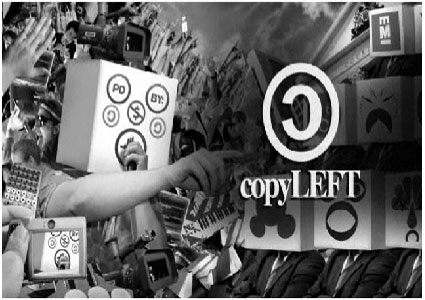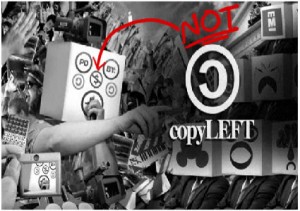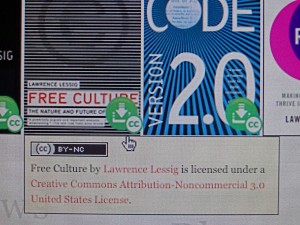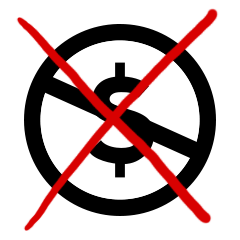Adapted from a talk and slide show I presented at the Open Knowledge Conference in Berlin on July 1, 2011. –NP
Crossposted from ninapaley.com
Free software is a matter of the users’ freedom to run, copy, distribute, study, change and improve the software. More precisely, it means that the program’s users have the four essential freedoms:
- The freedom to run the program, for any purpose (freedom 0).
- The freedom to study how the program works, and change it to make it do what you wish (freedom 1). Access to the source code is a precondition for this.
- The freedom to redistribute copies so you can help your neighbor (freedom 2).
- The freedom to distribute copies of your modified versions to others (freedom 3). By doing this you can give the whole community a chance to benefit from your changes. Access to the source code is a precondition for this.
These are the Four Freedoms of Free Software. They are foundational principles, and they are exactly right. They have served and continue to serve the Free Software Movement very well. They place the user’s freedom ahead of all other concerns. Free Software is a principled movement, but Free Culture is not – at least not so far. Why?
1. The No Derivatives (-ND) Restriction
If you tinker with software, you can improve it. You can also break it or make it worse, but the Freedom to Tinker is one of the foundational 4 Freedoms of Free Software. Your software may also be used for purposes you don’t like, used by “bad people,” or even used against you; the Four Freedoms wisely counsel us to GET OVER IT.
Unfortunately, The Free Software Foundation does not extend “Freedom to Tinker” to Culture:
Cultural works released by the Free Software Foundation come with “No Derivatives” restrictions. They rationalize it here:
Works that express someone’s opinion—memoirs, editorials, and so on—serve a fundamentally different purpose than works for practical use like software and documentation. Because of this, we expect them to provide recipients with a different set of permissions (notice how users are now called “recipients,” and their Freedoms are now called “permissions” –NP): just the permission to copy and distribute the work verbatim. (link)
The problem with this is that it is dead wrong. You do not know what purposes your works might serve others. You do not know how works might be found “practical” by others. To claim to understand the limits of “utility” of cultural works betrays an irrational bias toward software and against all other creative work. It is anti-Art, valuing software above the rest of culture. It says coders alone are entitled to Freedom, but everyone else can suck it. Use of -ND restrictions is an unjustifiable infringement on the freedom of others.
For example, here I have violated the Free Software Foundation’s No-Derivatives license:
The Four Freedoms of Free Culture:
1. The freedom to run, view, hear, read, play, perform, or otherwise attend to the Work;
2. The freedom to study, analyze, and dissect copies of the Work, and adapt it to your needs;
3. The freedom to redistribute copies so you can help your neighbor;
4. The freedom to distribute copies of your modified versions to others. By doing this you can give the whole community a chance to benefit from your changes.
(link)
Without permission, I’ve created a derivative work: the Four Freedoms of Free Culture. Although I violated FSF’s No-Derivatives license, they violated Freedoms # 2 and 4, so we’re even.
1. The Non-Commercial (-NC) Restriction
The Freedom to Distribute Free Software is essential to its success. It has given rise to many for-profit businesses that benefit the larger community.
Red Hat, Canonical – would the world be better if such companies were forbidden? Would Free Software benefit from a ban on those businesses?

Yet the Cultural ecosystem is stunted by the prevalence of Non-Commercial restrictions. These maintain commercial monopolies around works, and – especially for vocational artists like me – are functionally as restrictive as unmodified copyright. Yet they are widely mislabeled “Free Culture,” or even “Copyleft.”

This is a still from the mostly excellent and popular documentary RiP: A Remix Manifesto. This film is many peoples’ introduction to the term “Free Culture” and “Copyleft.” But as you can see, the Non-Commercial restriction is lumped in with actual Free license terms.
See that dollar sign with the slash in it? That means Non-Commercial restrictions, which are most definitely NOT Copyleft. (I’ve posted about Creative Commons’ branding confusion before, but it’s only gotten worse since then.)

This film is itself licensed under unFree Non-Commercial restrictions. As an artist and filmmaker, I have found confusion is rampant among my creative colleagues. Some filmmakers are beginning to think the term “Free Culture” is cool, but they still want to restrict others’ freedom and impose commercial monopolies on their works.

The book Free Culture by Lawrence Lessig its itself not Free culure, but it is widely looked up to. It sets an unfortunate and confusing example with its Non-Commercial license. It illustrates the absence of guiding principles in the Free Culture movement.
I have spoken to many artists who insist there’s “no real difference” between Non-Commercial licenses and Free alternatives. Yet these differences are well known and unacceptable in Free Software, for good reason.

Calling Non-Commercial restrictions “Free Culture” neuters what could be an effective movement, if it only had principles.
So what do I want?
I want a PRINCIPLED Free Culture Movement.
I want Free Software people to take Culture seriously. I want a Free Culture movement guided by principles of Freedom, just as the Free Software movement is guided by principles of Freedom. I want a name I can use that means something – the phrase “Free Culture” is increasingly meaningless, as it is often applied to unFree practices, and is also the name of a famous book that is itself encumbered with Non-Commercial restrictions.
I want a Free Culture ecosystem that allows artists to make money. I want anyone to be able to accept money for their work of remixing and building on Culture – just as a trucker can accept money for driving on a road. I want money to be among the many incentives to participate in building culture. Without the freedoms to Tinker and Redistribute without restriction, there is little incentive to build on and improve cultural works. There is little reward to help your neighbor, when you are guaranteed to lose money doing so. “Free Culture” with non-Commercial restrictions will remain a hobby for those with a surplus of time and labor, and those who only accept money from monopolists.
I want commerce without monopolies. I want people to understand the difference.
I want a Free Culture ecosystem that includes equivalents of businesses like Red Hat and Canonical. I want cultural businesses that give back to their communities, that work with their customers instead of against them. Only if we refuse to place Non-Commercial and No-Derivatives restrictions on our works will a robust Free Culture ecosystem be able to emerge.
I want the Free Software community – those who currently best understand the Four Freedoms – to champion the rest of Culture, not just Software. I want Freedom for All.


The free Culture movement does have principles, it’s just that you don’t agree with those principles. The ND and NC restrictions are useful for many people for many situations, so should be encouraged, because they give more freedom than “all rights reserved”.
Usefulness is not the measure of whether something is part of Free Culture. After all, publishing companies have gotten quite a bit of “use” out of copyright restrictions. ND and NC are not part of free culture because they are not freedoms, they are restrictions that serve to lock up our own collective culture. A work that is labeled as such could be stuck dead in the water, regardless of how good it is. No one (besided the original author) can distribute it without burdening themselves financially. No one can build upon it so that it can be a living, evolving part of our culture. It may not be as stifled as a work burdened by copyright, but it is not a completely free part of our culture. How can the Free Culture Movement stand on principles which fold in on themselve in this way? To proclaim “Culture should be Free!!!!!* (*but not my work, in terms of commercial distribution or derivation)”
Completely agree.
If you do a great piece of art and licence it NC so only you can sell it, then other person remix it into something more great, you can’t sell that remix (unless strict permission).
ND works, can’t become iconic remixes two decades after,
These restriccions slow spreading of the works, so they also slow the ability to become an stablished artist.
“The free Culture movement” as opposed to “The Free Culture movement”
So that would be the gratis Culture movement as opposed to the libre Culture movement?
Some of us are not concerned with the gratis Culture movement but are concerned with the libre culture movement. NC and ND restrictions do not fall within the latter. At least not as some view it.
all the best,
drew
There is another problem with ND restriction: The work can’t be translated!
The “aesthetic” versus “utilitarian” argument is about a different issue: “aesthetic” works are appreciated for their intrinsic value, we appreciate them directly. When we talk about “using” a digital aesthetic work, we frequently mean copying it all or in part.
For a “utilitarian” work we not primarily interested in the work itself, but in what it allows us to do. The work is a catalyst (typically towards making another, mostly unrelated work). The result of “using” a utilitarian digital work (e.g. a program) is NOT a copy of the utilitarian work, but is something else entirely.
For example, if you write an article about computers, and you “use” a photo of a computer, then you mean that the photo is part of the final article. If you “use” a word processor to write the article, though, the word processor is NOT part of the final work.
There are some gray areas. A “font” is partly a utilitarian work (e.g. kerning rules embedded in the font), but partly aesthetic (actual letter shapes, which become part of the final document).
This dichotomy makes a HUGE difference in the available business models for commercially creating free-licensed digital works. Until rather recently, I was under the impression that the outlook for aesthetic works was MUCH bleaker than that for utilitarian works. This perception was one of the reasons for the persistence of the CC “NonCommercial” licenses (i.e. the inability to remunerate artists using the models which existed for free software).
The thing is, though, there are some pretty significant models that work ONLY for aesthetic works (the “fan-based” models are much less lucrative for utilitarian works — because you don’t have “fans”, you have “users” — who are much less emotionally involved with your work, and will be just as happy to use a competing work). Of course, having said that, it’s possible to recognize the tail-end of the aesthetic behavior with utilitarian works and vice-versa. How else to explain “religious wars” between Emacs and Vi users, right?
I maintain that the distinction is useful, however, because it helps in selecting the best business model to support your work. “Service and support” is a great choice if you are primarily creating a utilitarian product. “Fan based merchandising” is a great choice if you are making an aesthetic work. There will be works that fall in between — in those cases, both models will be weaker than ideal, but then again you can use both at once.